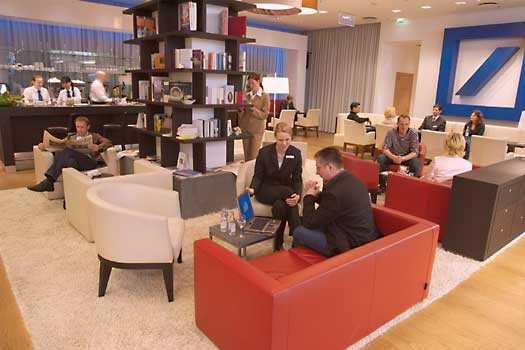Is this really a bank? Or a cafe? Or a lounge? Is this the right place? Where are the counters? The cubicles?

Staring at a wide-open space that leaves you scratching your head and furrowing your brow: Is this really a bank? Or a cafe? Or a lounge? Is this the right place? Where are the counters? The cubicles? It makes me glad to see the Q110- the Deutsche bank of Future retail in Berlin. It is a great example of what a bank could be in a mundane and often boring banking world. Here the customers are called guests and are greeted with a very friendly atmosphere and ushered into comfortable meeting rooms built in the bank branches.
Their planning began with a totally new approach to what a bank should be and how the physical and virtual experience should be, to their services, touchpoints, and interactions. Their approach strongly reflects a vision that is based on service design principles, where the bank branch is not designed in the typical way of optimising space at the cost of customer experience and services that are not planned only to achieve sales.

Bankers and Leaders need to understand that the banking process is part of a service, from the moment the customer thinks of a bank or a financial product, or walks in or logs into a bank portal or app, or using a payment gateway, or using helplines or bots, and until he leaves the bank or logs out and later opts again to use the service. Service design focuses on the overall experience and the design of the service delivery processes and strategy. It focuses on crucial points of contact with customers such as initial interaction whether virtual or physical, engagement phase, and post-consumption experiences. While planning a banking service experience, one also needs to find a balance between user needs, the business vision, underlying processes, technology intervention possibilities, and market scenarios.

According to a recent survey by PWC, there are 3 main trends in the state of the banking sector in 2020:
- Develop a customer-centric perspective and create a frictionless user journey
- Real-time intelligent data integration through artificial intelligence and cognitive computing
- Open banking solutions
One of the tools used in the planning of the service is the service blueprint. This is a macro planning tool that allows the service designer to see beyond the product or service and to have a clear picture of the entire system that brings the customer experience to life.
Compared to customer journey mapping, which primarily examines customers’ overall journey in using a banking product or a service, service planning maps the behind-the-scenes interlinks between processes, tools, technology, and people, and thus provides a 360-degree overview of the entire service.
Trust, empathy, and commitment are additional aspects that a modern customer seeks when choosing their financial service provider. This means banks need to develop banking processes that allow customers to be open, honest, and encourage them to voice their problems freely, build trust with their clients. The purpose of the service plan is to explore how the structures supporting customer journey work, what are the responsibilities, and what are the rules that determine what can and cannot be implemented.
(This Perspective was originally published on April 9, 2021 by Shekhar Badve on LinkedIn)
